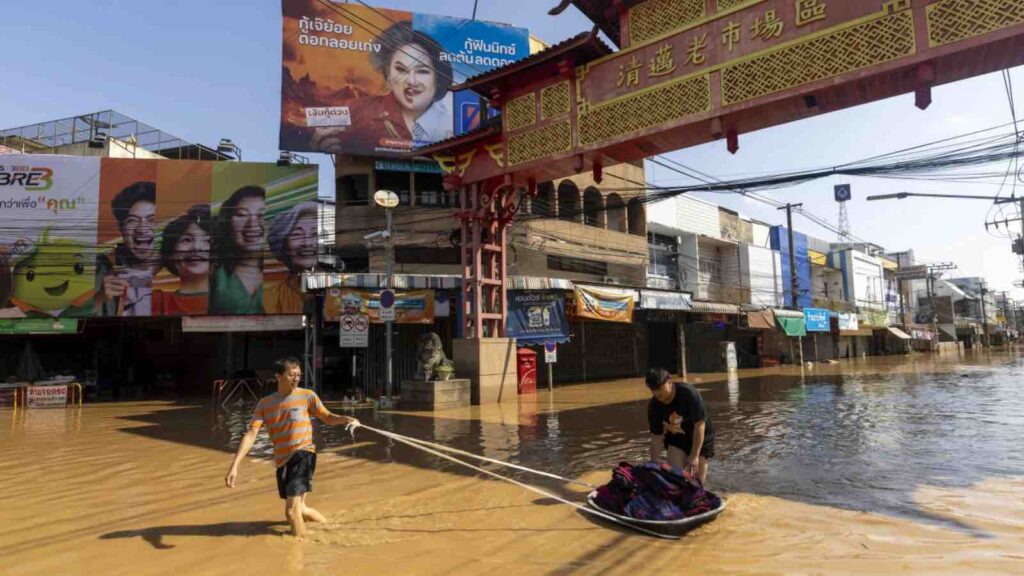As the waters slowly recede from flood-ravaged Chiang Mai, Central Thailand is preparing for the next wave of challenges.
Following weeks of relentless rain, the country’s Irrigation Department has announced it will release water from the Chao Phraya Dam, raising fears of further flooding across key provinces, including the bustling capital, Bangkok.
RELEVANT SUSTAINABLE GOALS



Weathering the Storm in Chiang Mai
Just days ago, the northern city of Chiang Mai was gripped by severe flooding, after the Ping River, which winds through the city’s eastern edge, overflowed its banks. Floodwaters surged through the streets, cutting off entire neighborhoods and leaving some residents, especially the elderly, stranded in their homes. Waist-deep or higher, the water forced local rescue teams into action, delivering food and evacuating those most vulnerable, while parts of the city were plunged into darkness due to safety-driven power outages.
Even the city’s most popular tourist spots weren’t spared. The iconic Night Bazaar and Tha Pae Gate were submerged under a meter of water, creating eerie scenes in areas typically filled with the bustle of visitors and local vendors.
A Struggle for Survival: Animals in Peril
As the floodwaters rose, concern turned to the elephants residing in Chiang Mai’s nature sanctuaries and parks. At the renowned Elephant Nature Park, home to 125 elephants, caretakers raced against time to lead the animals to safety. Some elephants instinctively sought higher ground, but not all were as fortunate. Images circulated in Thai media showed elephants struggling to keep their heads above the floodwaters, and tragically, two were found dead, with others still unaccounted for.
This loss underscores the widespread toll of the flooding, affecting not only human lives but also the wildlife that plays a vital role in Thailand’s cultural and ecological identity.
Cleanup Begins as Waters Recede
On Monday, Chiang Mai took its first steps toward recovery as the city began a large-scale cleanup. The Ping River, which reached an unprecedented height of 5.3 meters on Saturday night, has started to recede. By 10 a.m. Monday, water levels had dropped to 3.85 meters, a positive sign according to Kuakul Manasamphansakul, the Chiang Mai Irrigation Office director.
Tractors and water trucks were dispatched to clear thick layers of sediment from areas surrounding the city’s key bridges, including Naowarat, Nakhon Ping, and Rattanakosin. These bridges serve as crucial transport links, and their restoration is a priority as Chiang Mai looks to reconnect its flooded neighborhoods.
Road closures remain in place for several key arteries, including the popular tourist and business streets of Chang Khlan and Charoen Prathet, further complicating recovery efforts. Municipal workers and volunteers continue to deliver essentials like food and drinking water to households still isolated by the floodwaters.
Despite these hardships, there is a cautious sense of optimism. “The Ping is receding at four or five centimeters an hour,” said Manasamphansakul. This steady decline offers hope that the river will soon fall below critical levels, allowing the city to regain a semblance of normalcy.
Central Thailand Prepares for the Next Flood Threat
While Chiang Mai begins to dry out, provinces in central Thailand are now bracing for the possibility of more flooding. The Irrigation Department’s decision to release water from the Chao Phraya Dam comes as a necessary step to prevent the dam from exceeding capacity. However, it raises the risk of inundation downstream, particularly in low-lying areas and the capital, Bangkok.
Bangkok has seen its share of seasonal flooding, but with reservoirs and rivers already swollen from weeks of rain, officials are warning residents to prepare for possible water surges. The city’s intricate system of canals and flood defenses will be tested as authorities work to manage the controlled release from the dam.
Flooding is not a new problem for Thailand. Each year during the monsoon season, the country grapples with torrential rains that lead to swollen rivers, breached dams, and submerged cities. Yet, as climate change intensifies weather patterns, the severity and frequency of such events have increased, leaving communities vulnerable.
This year’s floods in Chiang Mai are a stark reminder of how quickly a city can be transformed by nature’s forces. Residents are left not only to pick up the pieces but also to confront the broader questions of how to better prepare for future disasters. Improved infrastructure, early warning systems, and resilient community planning will be crucial in helping Thailand mitigate the impact of the annual monsoons.
The lessons from this flooding season will likely shape future policies, as Thailand grapples with how to protect its people, wildlife, and cultural heritage from the increasingly unpredictable forces of nature.
As the country braces for what’s to come, one thing is clear: this annual battle with water will require innovative solutions and a united effort. From emergency rescue teams navigating submerged streets to the caretakers ensuring the safety of their elephants, Thailand’s response to the floods shows resilience in the face of overwhelming odds. However, as the climate crisis continues to intensify, the need for long-term, sustainable strategies has never been more urgent.
Lead image courtesy of AP Photo/Wason Wanichakorn (People drag their belongings through floodwaters in Chiang Mai Province, Thailand, Sunday, Oct. 6, 2024 as the city’s main river overflowed its banks following heavy seasonal rainfall).
You may also be interested in :
Super Typhoon Krathon Ravages Asia : A Rare and Devastating Storm




